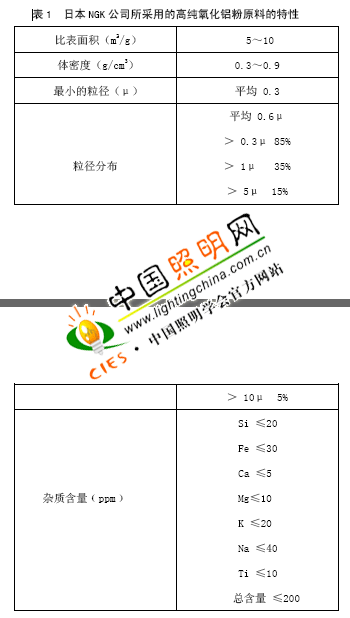Ceramic tube for high intensity discharge lamps
Department of Light Source and Lighting Engineering, Fudan University
Abstract: A brief introduction to the requirements for ceramic tubes for high-intensity discharge (HID) lamps; preparation of high-purity alumina powder; fabrication of cylindrical and non-cylindrical ceramic tubes; and development of transparent ceramic tubes for HID lamps The situation.
Key words: high intensity discharge lamp, ceramic tube forming method, high purity alumina powder, PCA material
As an arc tube material for HID light sources such as high pressure sodium lamps and metal halide lamps, the following requirements must be met:
(1) has a high light transmittance;
(2) can achieve hermetic sealing;
(3) It can resist the erosion of sodium and metal halides under high temperature and high pressure;
(4) low conductivity at high temperatures;
(5) Low evaporation rate at high temperatures;
(6) It has sufficient mechanical strength to withstand the thermal shock of the light switch.
Until the first half of the 1960s, GE invented polycrystalline alumina-PCA (Polycrystalline Alumina) ceramic tubes, quartz glass is the most important arc tube material. GE successfully manufactured high pressure sodium lamps with PCA. At the time their trademark was Lucalox (transLUCent ALuminium OXide). In the early 1990s, Philips invented ceramic metal halide lamps based on white light high-pressure sodium lamp technology. The quartz tube can withstand a working temperature of 1300K, while the ceramic tube can withstand a working temperature of up to 1500K, so the performance of the ceramic metal halide lamp is much better than the quartz metal halide lamp. Obviously, the quality of PCA is very critical for these high intensity discharge lamps. To this end, people have done a lot of research and development. In the following, a brief introduction will be made on the manufacture of cylindrical ceramic tubes, the formation of non-cylindrical ceramic tubes, and the case of transparent ceramic tubes.
1Manufacture of cylindrical ceramic tubes
The processing of cylindrical ceramic tubes consists of 3 steps:
(1) Preparation of high purity alumina powder;
(2) forming of a cylindrical ceramic tube;
(3) Sintering process.
1.1 Preparation of high purity alumina powder
The raw material purity of the alumina powder used to make the arc tube must be high, reaching 99.99%. Why is this high purity? Because as long as there are impurities, even if it is small, it will cause some undesired effects. For example, it causes discoloration of the powder; during the sintering process, irregular crystal grains are generated; the grain boundaries are separated, so that the impurities are easily moved to the grain boundaries, and the impurity concentration there is increased. In addition, in order to obtain a high-density pipe, the sintering activity of the powder is good. This requires the powder to have a specific morphological structure, specifically, the particle size is very fine (about 0.3 μm), and the particle size distribution is very concentrated.
The raw material of PCA, α-Al2O3, is obtained by burning aluminum sulfate ammonia (AlNH4(SO4)2.24H2O) containing crystal water:
AlNH4(SO4)2.24H2O→Al2O3+NH3+SOx
At 10000 C, a bulk of Al 2 O 3 (having a specific surface of 125 m 2 /g, a density of 0.15 g/cm 3 , a particle diameter of 0.02 μm) was first formed, and then converted to α-Al 2 O 3 at 1200 to 14000 C. Next, the powder of the group was further dispersed to obtain α-Al 2 O 3 powder having a density of 0.4 g/cm 3 , an average particle diameter of 0.6 μm, and a specific surface area of ​​6 m 2 /g.
Table 1 lists the characteristics of the high-purity alumina powder raw materials used by NGK Corporation of Japan.

